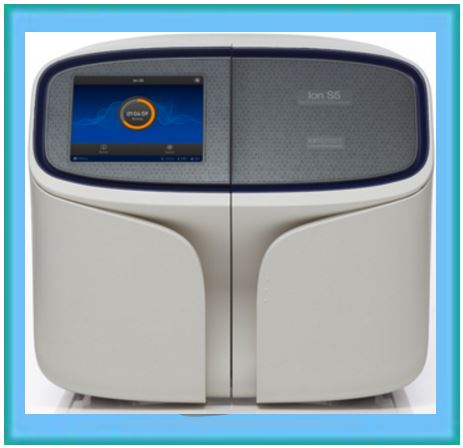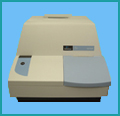Legacy Instruments
The following instruments are physically still present in the Core's inventory or have been transferred elsewhere in the Department. With regard to transferred instruments, you must contact the indicated person if you wish to use the instrument.
As for legacy Core instruments, usage is either not possible or significant preparatory work & expense will be required to bring them online. Thus, if you are interested in these instruments, please contact the Genomics Core for further information.
Alternatively, if you wish to propose that a new instrument be purchased for the LSU Genomics Core, please follow the instructions at Potential Instrument Acquisitions.
Listing
Ion Torrent S5
 The S5 provides options for both high and low-to-moderate NGS throughput. The 540 chip can generate modal read lengths of up to 200-bp (maximum size is ~250-bp), while the 520 and 530 chips can generate modal read lengths of up to 400-bp (with emulsion PCR by the OneTouch·2) and 500-bp ( with Isothermal amplification).
The S5 provides options for both high and low-to-moderate NGS throughput. The 540 chip can generate modal read lengths of up to 200-bp (maximum size is ~250-bp), while the 520 and 530 chips can generate modal read lengths of up to 400-bp (with emulsion PCR by the OneTouch·2) and 500-bp ( with Isothermal amplification).
Typical post-filtering yields by chip type:
Read output can be higher for very high quality NGS libraries that result in low levels of polyclonal ISPs and minimal filtering for low-quality reads.
Sequencing is based on pH changes associated with the incorporation of native nucleotides; data accuracy is improved by incorporating flow-space information (i.e., which nucleotide was being flowed across the chip at the time of incorporation) into basecalling... as well as in downstream mapping with Ion-optimized software, TMAP.
The Ion S5 combines semiconductor sequencing technology with natural biochemistry to directly translate chemical information into digital data. The Torrent Suite Software performs preliminary reference genome alignment and outputs data in FASTQ and BAM (aligned or un-aligned) formats for easy downstream analysis with optional third party analysis tools. Depending on the chip and kits used, final reads from a single run range from ~20-30 million (up to 400bp) or ~60-80 million reads (up to 200bp).
Services provided
Typically, libraries are prepared by the Client; however, under certain circumstances, the Genomics Core will prepare the libraries from DNA provided by the researcher. The Genomics Core performs the Library QC assay, templating (by emulsion PCR on the OneTouch·2 or Isothermal Amplification), the S5 reaction (sequencing), and production of data output files (FastQ, un-aligned BAM, or BAM; split by barcodes, if applicable). If an appropriate genome is provided to the Core, the data will be aligned on the Torrent Server using TMAP... software optimized for Ion Torrent data by incorporating flow-space information.
How the S5 works
The sequencing technology underlying the S5 exploits a well-characterized biochemical process. When a nucleotide is incorporated into a strand of DNA by a polymerase, a hydrogen ion (H+) is released as a byproduct. This hydrogen ion carries a charge which the S5's ion sensor (essentially the world's smallest solid-state pH meter) can detect. As the sequencer floods the chip with one nucleotide after another, any nucleotide added to a DNA template will be detected as a voltage change, and the S5 will call the base. If a nucleotide is not a match for a particular template, no voltage change will be detected and no base will be called for that template.
A principal component of the S5 is the sequencing chip. This microprocessor chip incorporates an extremely dense array of micro-machined wells married to a proprietary ion sensor. Each well contains a different DNA template, allowing massively parallel sequencing. Two chip sizes are available:
-
400-bp or 500-bp chemistry:
- 530 chip: ~38 million wells (~20 million Final Reads). 200bp chemistry:
- 540 chip: ~148 million wells (~60-80 million Final Reads).
A more extensive explanation of the platform can be found at the manufacturer's website, Ion Torrent S5
Documents
Cost Considerations
Keep the following points in mind when preparing proposals for NGS experiments, whether you do them here or send samples elsewhere. In particular, when comparing costs of performing your experiment with an Illumina-based Core vs. an Ion-based Core, ensure that you are truly comparing 'apples-to-apples'.
Adapters
Ion sequencing uses two adapters, with the template being attached to the ISP (i.e., the sequencing surface) by the P1 adapter and sequencing occurring from the A1 adapter. For some projects, it may be preferable to use a truncated P1 (trP1) adapter.
Barcodes
We strongly recommend using Ion's barcode sequences rather than designing your own barcodes or using primer-sequences as surogate barcodes.
Run Times
With the S5, most samples can be fully processed (library QC, templating, and S5) within 2-3 days. The sequencing reaction run time varies with read length (up to 400-bp) and chip type (520, 530, or 540).
Data Analysis
Generally speaking, data analysis will be the Client's responsibility. However, as needed, the Genomics Core will provide support with regard to enlisting help from its Ion contacts. Please note that NGS experiments generate massive amounts of data, in the form of hundreds of thousands to millions of reads. Currently, reads from the S5 are ≤400-bp long (when using the OneTouch·2 Templating kits) or ≤500-bp ( if using the Isothermal Amplification kits for templating). Thus, data analysis can actually be the hardest portion of an NGS experiment.
General Recommendations
Next-Generation Sequencing (NGS) experiments are expensive and more complex than traditional Sanger-sequencing. Further, analysis of NGS data is not trivial. Thus, to fully leverage the S5 platform, you need a thorough understanding of the instrument's abilities with regard to your research question and a sound experimental design – including how to analyze the resulting Gb of data – before preparing your templates.
Victor·3 Multilabel Counter
 This instrument, which is owned by Dr. Stephen Hand, has been returned to his lab; if you wish to use it, you must contact Dr. Hand. The Victor·3 Multilabel Counter (model 1420-011) includes fluorescence intensity (both top and bottom reading), luminescence, and absorbance (VIS) technologies as well as scanning, shaking and kinetics features. The instrument accepts all types of microtitration plates (from 1 to 1536 wells), as well as Petri dishes, slides, filters and Terasaki plates. Not all features described in the associated Victor·3 documents are applicable to this model.
This instrument, which is owned by Dr. Stephen Hand, has been returned to his lab; if you wish to use it, you must contact Dr. Hand. The Victor·3 Multilabel Counter (model 1420-011) includes fluorescence intensity (both top and bottom reading), luminescence, and absorbance (VIS) technologies as well as scanning, shaking and kinetics features. The instrument accepts all types of microtitration plates (from 1 to 1536 wells), as well as Petri dishes, slides, filters and Terasaki plates. Not all features described in the associated Victor·3 documents are applicable to this model.

